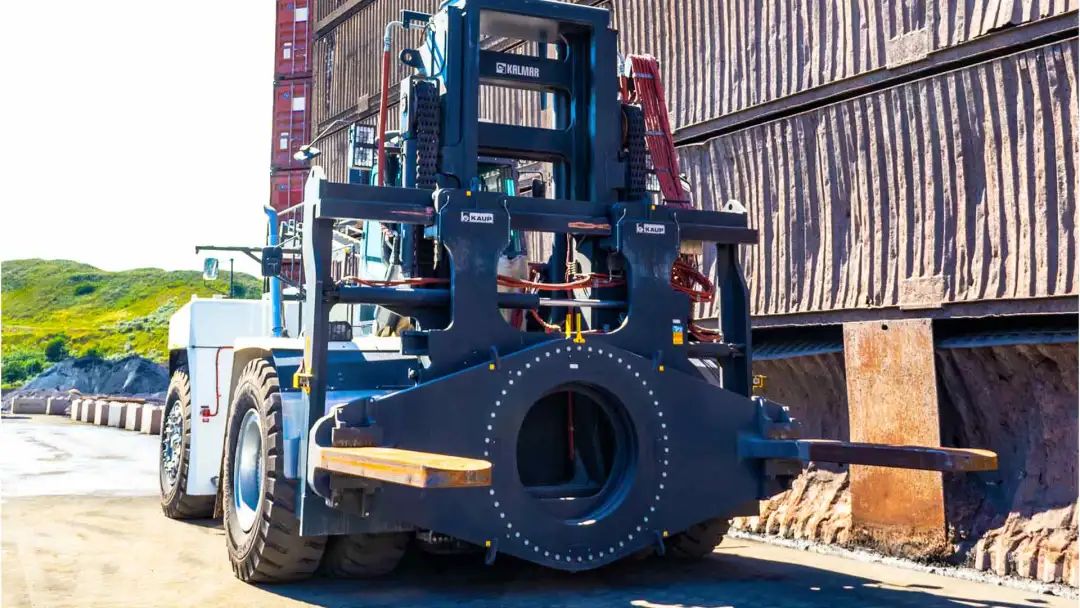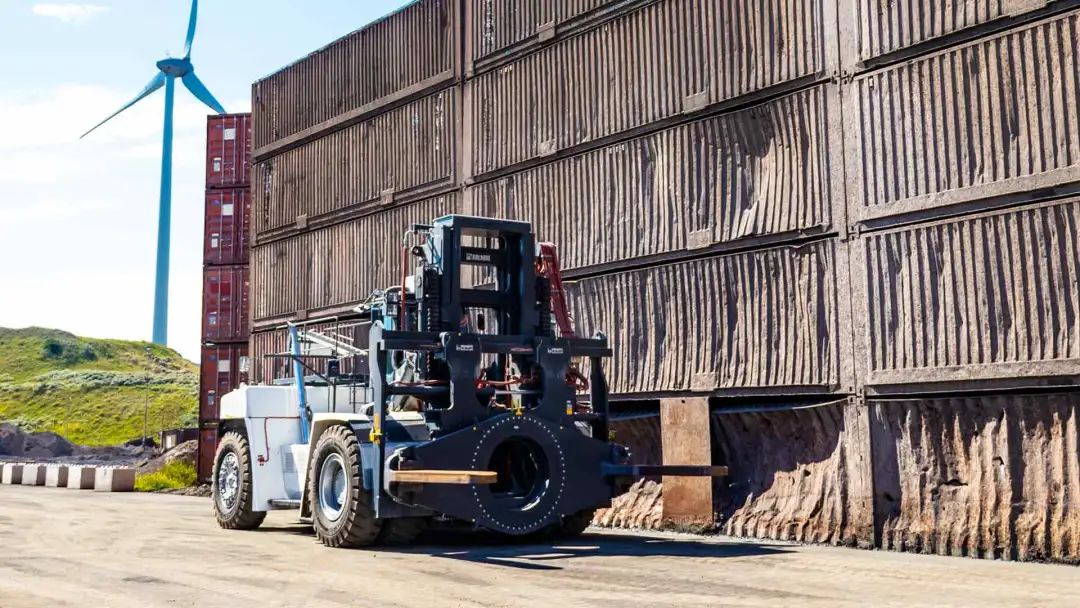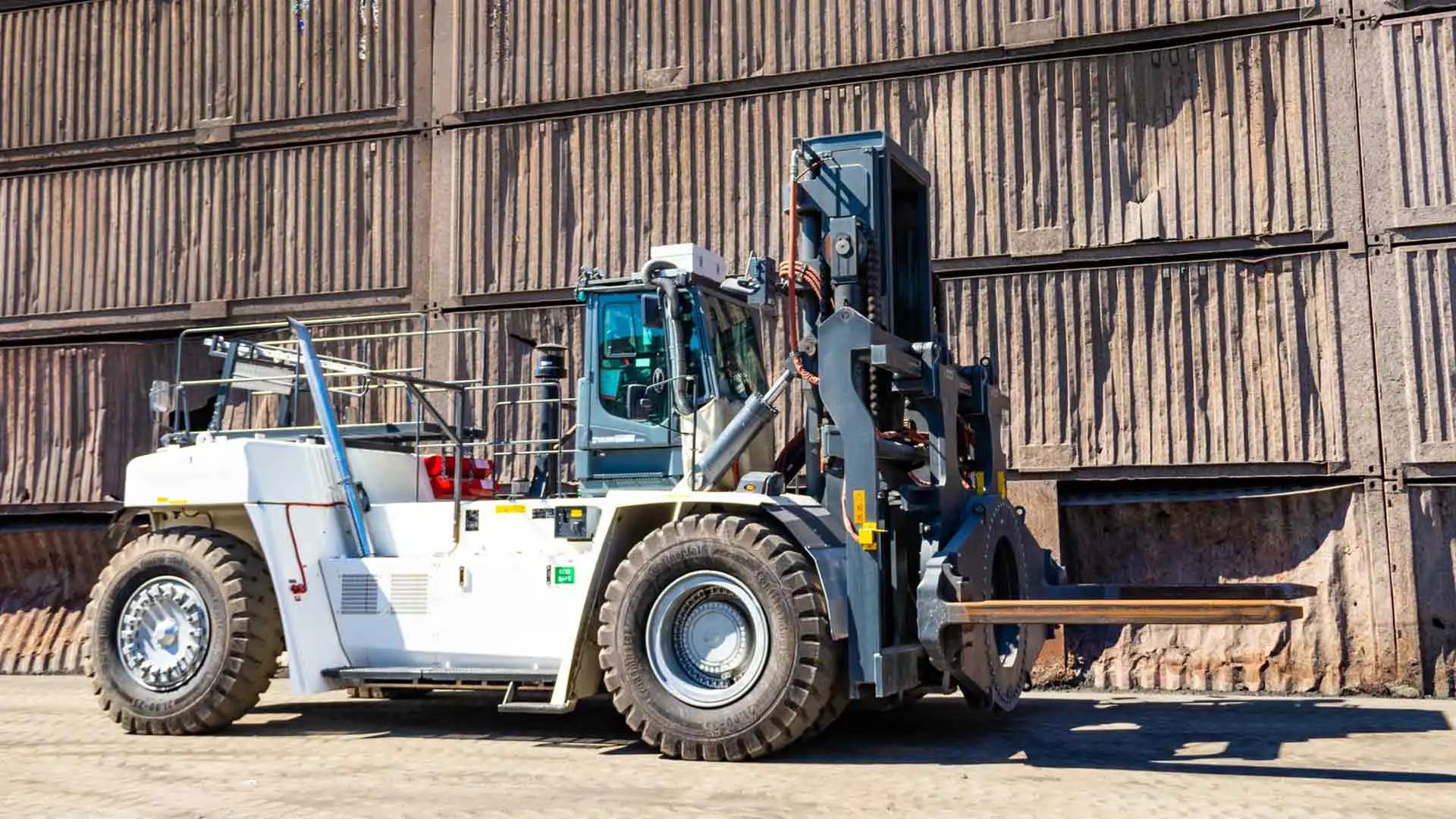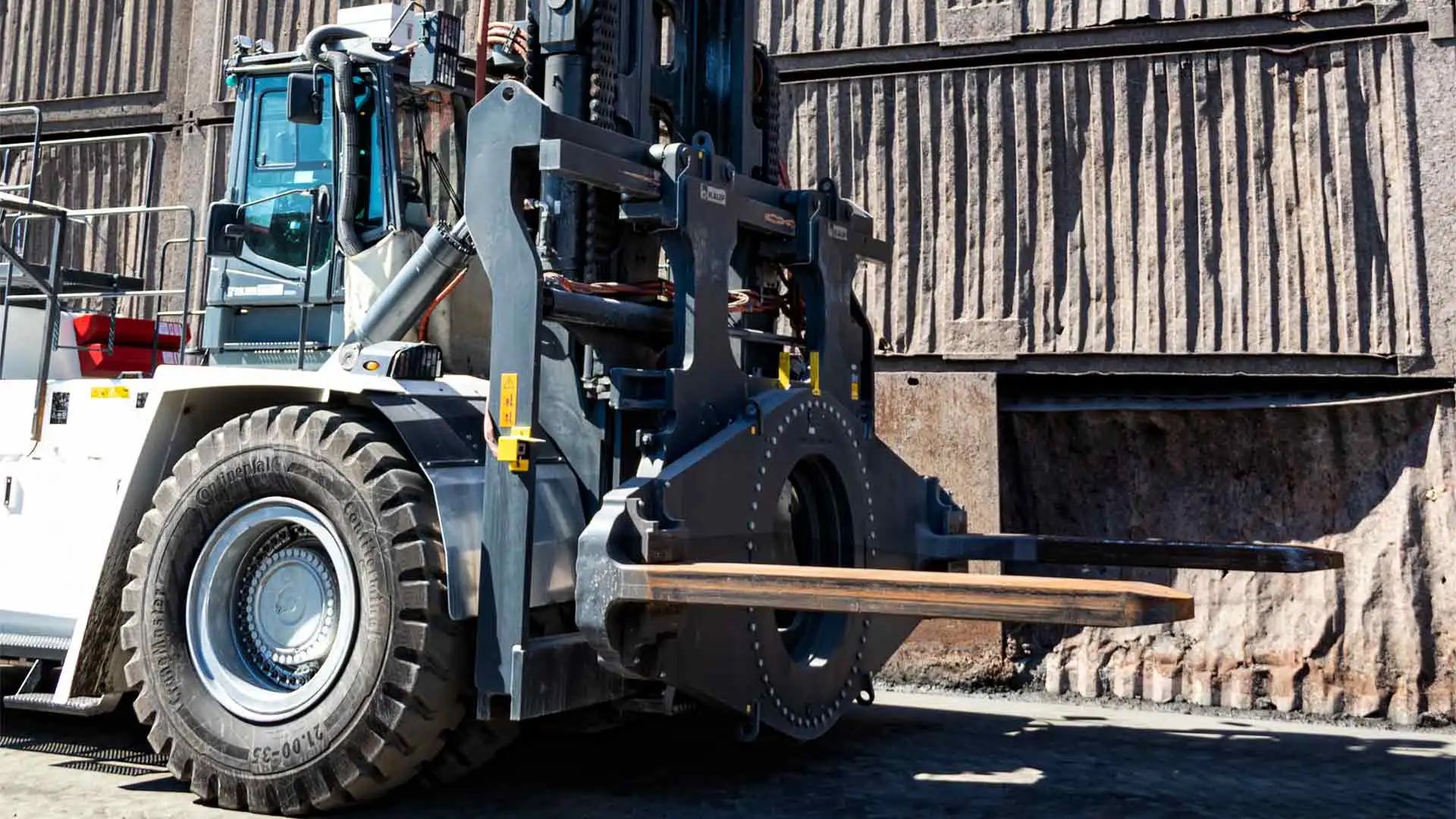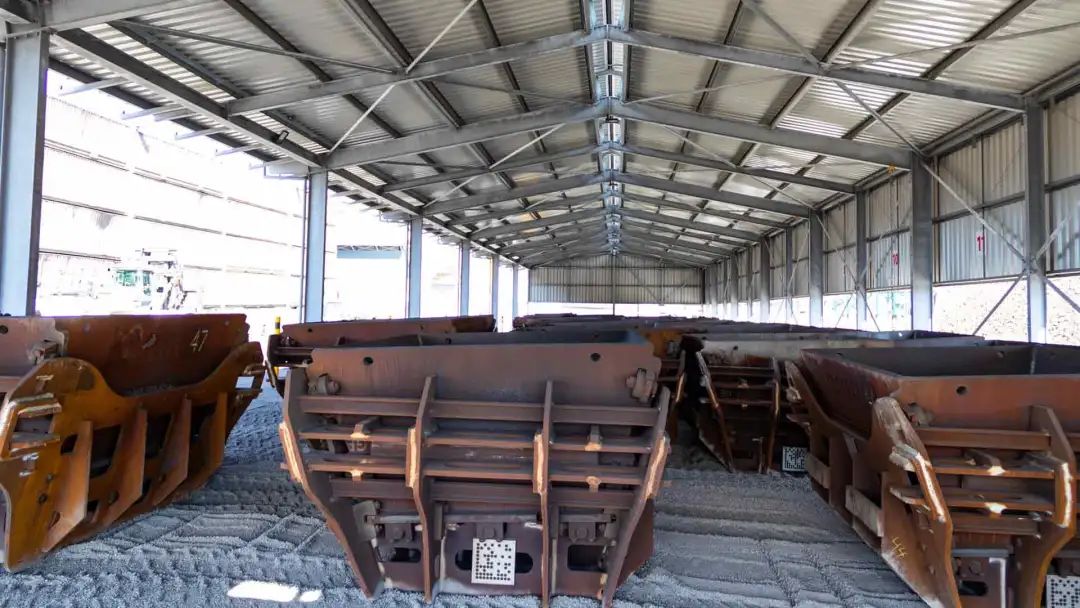案例分享 | 靠普旋转器!
转载 2021-10-13 13:19 靠普叉车属具 来源:靠普叉车属具
Case studies
案例分享
“This is the Biggest”
Case studIes
Special operating environments, individual customer requirements and the creative solutions of the KAUP development department:
Review here some case studies of special KAUP attachments used by our customers.
Maybe you spot a solution for your special requirement. If not, together we can find the right attachment for your demand.
案例分享
对于特殊的作业环境、个性化的客户需求,KAUP可提供创造性的解决方案:
这里回顾一些客户使用的特殊KAUP属具。
也许你能找到一个解决方案处理特殊需求。如果没有,我们可以一起找到适合您需求的属具。
Discover 60 Tons Rotator
Industrial service provider
工业服务提供商
A project of superlatives: the largest attachment ever built by KAUP. Designed and produced in record time: the length of the project between initial contact and putting into service not even a year.A project that is much more than two rotators each with a load capacity of 45 tonnes – it is a milestone for KAUP.
超级项目:KAUP史上最大的属具。从设计研发到生产记录来看,项目从最初签订合同到完成生产投入使用,总计时长不到一年。这不仅仅是两个旋转器(每个旋转器承载能力为45吨) 的项目 - 也是KAUP里程碑似的标志。
Two giants in record time
You can taste the salt in the air. You can sense the sea. A windmill rotates on the dyke. Directly on the North Sea, north-west from Amsterdam. But here there is not just the tourist idyll, but also the only steelworks in the Netherlands can be found here. Put more precisely, in IJmuiden, in the province of North Holland. Over 8,000 people work on this side of the dyke in an area the size of a medium-sized provincial town. And numerous industrial service providers work in that area and deal with, for example, the removal and processing of the slag produced by the steel production process. It is a by-product of steel manufacture and is used, for example, as the subgrade in road construction.
你可以感觉到空气中的咸味,感受到大海,风车在堤坝上旋转。至北海边上,从阿姆斯特丹到西北方向,这里不仅有旅游圣地般的田园风光,还有荷兰唯一的钢铁厂。更准确地说,其位于北荷兰省的伊穆伊登。在一个中等规模的省会城镇大小的地区,有8000多人在堤坝的这一边工作。也有许多工业服务提供商在该领域工作,例如,清除和加工处理钢铁生产过程中产生的炉渣,它是钢铁制造的副产品,被用于公路建设中的路基。
Graphite dust in the air
空气中的石墨粉尘
In the past, the slag was collected in large ladles and moved to the edge of the site. There, massive gantry cranes emptied the containers in the open air so that the slag could cool before being processed. The disadvantage of this method was the production of huge amounts of graphite dust, which the inhabitants of the neighbouring community of Wijk aan Zee had to suffer from. And the fine graphite dust that arose is not only dirty. It also contains numerous harmful substances such as manganese, lead and vanadium. Continuing complaints by the citizens therefore led to the method being banned by the regional government in the spring of 2019.
以往,大型容器装满炉渣,转移到作业现场旁边。在那里,龙门吊在露天清空了容器,熔渣在加工前冷却。这种方法的缺点是产生大量的石墨粉尘,邻近社区的居民不得不忍受这种粉尘。而产生的细石墨粉尘不仅很脏,它还含有许多有害物质,如锰、铅和钒。因此,居民的持续投诉导致该作业方式在2019年春季被地方政府禁止。
Processes completely changed
“We were thus forced to do something quickly” explains a member of the project team, “and decided to completely change the existing process.” The solution? The building of a new hall to reduce the dust levels to zero using complex filter systems.
项目团队的一名成员说到:“为此,我们必须尽快采取行动,并决定彻底改变现有流程。”解决方案是建造一个室内空间,使用复杂的过滤系统将灰尘降到零。
At the same time, the customer wanted KAUP to make the slag disposal not only cleaner, but also redesign it to become more modern and fit for the future. Individual transport containers known as skips would replace the traditional ladles. “However, a new handling problem resulted from this” report other project team members. “After all, the skips can hold up to 23 tonnes of slag and needed to be emptied by a fork lift truck rather than a stationary device”. In addition, a fork lift truck would offer a range of application possibilities. “But until now such a large attachment did not exist for fork lift trucks that met our demands” continues the disposal professional, “which is where KAUP came in.”
与此同时,客户希望KAUP提供的解决方案,不仅能更加彻底的清除炉渣,而且需重新设计,使其更现代化,适合未来需求。未来,单独运输的集装箱将取代传统的容器。项目人员提到,“但是,这样又引发了一些系列新的问题。毕竟,容器需承载多达23吨的炉渣,需要使用叉车来搬运并清空,而不是固定式装置清空,并且叉车需提供额外的功能。但至此,满足我们要求的叉车还未配置合适的如此巨大的属具。” 专业人员继续说到,“这就是为什么需要KAUP专业属具的原因.”
Challenging design and production
The industrial service provider contacted KAUP for the first time in the spring of 2019. Everything happened very quickly from that point. An intensive exchange between a small design team at KAUP and the other members of the project team followed. “In the process we were confronted with a few interesting challenges” reports KAUP designer Bernd Ackermann. “The size of the device and the tight schedule were two aspects” according to Ackermann. “The adapted flanged couplings and the completely new welded fitting were two further decisive factors”, explains the experienced designer in addition. “Because we also hadn’t designed anything like this before.” But after about ten weeks – in October 2019 – the challenging production process could be begun. For example, the forks had to be welded manually to the huge base plate in a laborious process. Actually two times. After all, the customer ordered two 60T391.
2019年春,这家工业服务提供商初次与KAUP取得联系,从那时起,项目很顺利的开始了。随后,KAUP专业设计团队与项目团队进行了深入交流。设计人员阿克曼说到,“在这个过程中,我们遇到了一些挑战,设备的尺寸和项目的紧迫性是两个重要因素,匹配的法兰联轴器和全新的焊接配件是另外两个关键因素”,经验丰富的设计师还解释道,因为我们以前也没有设计过这类产品,但大约十周后—2019年10月—富有挑战性的生产过程启动。例如,我们需要在一系列复杂的工艺过程中,手工两次焊接货叉到巨大的底板上,毕竟,客户订购了两台60T391旋转器。
After intensive tests on in-house test rigs specially built for this project, the rotators weighing over 13 tonnes each left the factory in Aschaffenburg at the beginning of February 2020. The journey then began initially to Poland. There, the attachments, which are 4,600 mm wide and 3,475 mm high, were mounted onto huge Kalmar fork lift trucks. Afterwards was the journey to IJmuiden. This logistical challenge alone was enormous, because the complete fork lift trucks had to be partially dismantled for the transport. Otherwise they would not have fitted onto the trucks. Even so, four trucks were necessary for each fork lift for the transport to the Netherlands.
历经一系列专业室内测试,2020年2月初,每台重量超过13吨的旋转器离开了阿斯哈芬堡工厂,到达波兰,在那里,4600 mm宽、3475mm高的属具安装在巨大的卡尔玛叉车上,之后发往艾默登。运输如此庞然大物,本身物流也是巨大的挑战,因为在运输时必须部分拆卸叉车,否则,它们就不便装运在卡车上,即使如此,每台叉车仍需四辆卡车才能运到荷兰。
They have been in daily use there since mid-May 2020 and have since then completed thousands of loading cycles. “Our initial enthusiasm is still there, as the solution now in use meets all the demands we made” is how those responsible in the Netherlands summarise the project. They are “happy that we were able to implement this challenging project in this way“.
自2020年5月中旬起,KAUP旋转器每天都在那里工作,完成了数千次装载循环。”我们最初的期望仍然存在,现在的解决方案满足了我们提出的所有要求。”这是荷兰负责人总结项目时提到的,他们“很高兴KAUP能完成如此具有挑战性的项目”。
Current process
What do the loading cycles look like, and how is the new disposal process designed? The new skips are automatically loaded with slag in the steelworks 24/7. To be able to transport the skips more easily into the emptying hall, there is a special truck trailer – a so-called transport cassette. Two skips fit into the cassette. A terminal tractor takes it to near the hall. A Kalmar fork lift truck picks up the full skips and moves them in sequence into a roofed, open storage building. The full, still hot containers stay there to cool, so processing is possible. This starts with emptying the skips in the new factory building. Inside there are not only large misting machines that provide permanent humidity in the building to bind the dust that is caused, the slag unloading area with enormous suction systems and a highly modern filter system is found there as well. The rectangular area is on the edge of the building. Two sides are enclosed and two have an opening. These are used to bring in the hot slag on one side and to transport away the cooled remaining material on the other.
装载周期是什么样的?新的处理炉渣流程是如何设计的?新的容器在炼钢厂24/7自动装载炉渣。为了更容易地将容器运输到卸料大厅,有一种特殊的卡车拖车,即所谓的运输卡带。每两个容器装进运输卡带,然后由终端拖拉机把它拖到大厅附近。一辆叉车吊起容器,并将它们依次移入到一个有屋顶的仓库。满载并发热的容器留在那里继续冷却,处理过程是可行的。从清空新厂房中的容器开始,室内不仅有大型喷雾机,可控制室内长时期湿度,由此减少灰尘。在卸渣区域,有抽风系统和高度现代化的过滤系统。矩形区域位于建筑物的边缘,两边是封闭的,有两个开口,在一侧引入热熔渣,在另一侧运走冷却后的剩余材料。
The unloading process is then extremely simple. A Kalmar fork lift truck transports the full skip to the unloading point. During this a large curtain moves slowly down and closes off the third side of the unloading area. The fork lift truck-attachment combination stands on the remaining fourth side. Before it can continue, a temperature measurement is made. Only if this measures the correct, low temperature, a traffic light allows unloading. Afterwards, the hydraulics of the big Kalmar drive the 60T391. The full skip rotates. At around 90°, physics takes over. The extremely heavy, hot slag falls onto the floor with a thud and makes it shudder. Dust is caused. But outside the unloading point, there is no sign of this, as it is immediately sucked up and filtered. The rotator then returns the now empty skip to its original position. It is now ready for a new loading cycle.
卸载过程非常简单,叉车将整个容器运输至卸载点,期间,一个大卷帘缓慢向下移动,并关闭卸载区域的第三面,叉车属具位于第四侧,在继续作业之前,先测量温度。只有到正确的低温时,指示灯才允许卸货。之后,叉车液压系统驱动60T391旋转器,启动旋转功能。在90°左右,动作完成。极重的热熔渣砰的一声落在地板上,地面颤抖,引起灰尘。但在卸载点之外,不会出现这类问题,因为灰尘会立即被吸走并过滤。之后,旋转器将返回到其初始位置,等待下一轮作业。
